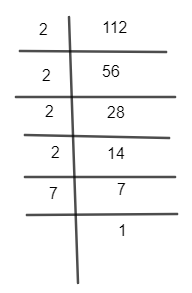
Answer
498.6k+ views
Hint: The number of subsets of m, n elements will be ${{2}^{m}},{{2}^{n}}$ respectively so it can be written as ${{2}^{m}}-{{2}^{n}}=112$. After that factorize 112 to separate factors of 2 and then equate the equation to get the desired result.
Complete step-by-step solution:
We are given two finite sets with m and n elements. If the number of elements is ‘l’ then the number of subsets are ${{2}^{l}}$.
Just for an example consider a set like {1,2,3} then its subsets are {1},{2},{3},{1,2},{1,3},{2,3},{1,2,3},{}.
Hence the numbers of elements were 3 and its number of subsets is ${{2}^{3}}=8$ which is given.
So if the elements of a set are m and n so the number of subsets are ${{2}^{m}}$ and ${{2}^{n}}$ respectively.
In the question we are given that the numbers of subsets with m elements are 112 more than the number of subsets with n elements.
So we can write as,
${{2}^{m}}-{{2}^{n}}=112\ldots \ldots (1)$
We can take ${{2}^{n}}$ common in left hand side of (1) we get,
${{2}^{n}}({{2}^{m-n}}-1)=112\ldots \ldots (2)$
Now let’s analyse the left hand side of (1) we can see that it’s a product of an even and an odd number. The even number will have only 2 as its prime factor so we can factorize 112 as,

So 112 can be written as ${{2}^{4}}\times 7.$
Now we will substitute it in equation (2) so we get,
${{2}^{n}}\left( {{2}^{m-n}}-1 \right)={{2}^{4}}\times 7\ldots \ldots (3)$
No, $\left( {{2}^{m-n}}-1 \right)$can never be equal to ${{2}^{4}}$ as one is odd and other is even.
So,
${{2}^{n}}={{2}^{4}}$
Now we can apply law which is when bases are equal exponents are the same.
So the value of n=4.
Now we will put n=4 in equation (3) we get,
${{2}^{4}}\left( {{2}^{m-4}}-1 \right)={{2}^{4}}\times 7$
which can be further represented as,
${{2}^{m-4}}-1=7\ldots \ldots (4)$
Now adding 1 in both the sides of equation (4) we get,
${{2}^{m-4}}=8$
Now we can represent 8 as \[{{2}^{3}}\] to make the bases equal so it can be further written as,
${{2}^{m-4}}={{2}^{3}}$
Applying law of indices which bases are same exponents are equal we get,
m-4 = 3
So, the value of m=7.
Hence the answer is B.
Note: In this question one can tell answer without even solving it as we know that the subsets of m elements are greater than that of n elements then m and n cannot be equal so option C, D cancels out and m should always be greater than n so option A. also cancels B. is the answer.
Complete step-by-step solution:
We are given two finite sets with m and n elements. If the number of elements is ‘l’ then the number of subsets are ${{2}^{l}}$.
Just for an example consider a set like {1,2,3} then its subsets are {1},{2},{3},{1,2},{1,3},{2,3},{1,2,3},{}.
Hence the numbers of elements were 3 and its number of subsets is ${{2}^{3}}=8$ which is given.
So if the elements of a set are m and n so the number of subsets are ${{2}^{m}}$ and ${{2}^{n}}$ respectively.
In the question we are given that the numbers of subsets with m elements are 112 more than the number of subsets with n elements.
So we can write as,
${{2}^{m}}-{{2}^{n}}=112\ldots \ldots (1)$
We can take ${{2}^{n}}$ common in left hand side of (1) we get,
${{2}^{n}}({{2}^{m-n}}-1)=112\ldots \ldots (2)$
Now let’s analyse the left hand side of (1) we can see that it’s a product of an even and an odd number. The even number will have only 2 as its prime factor so we can factorize 112 as,

So 112 can be written as ${{2}^{4}}\times 7.$
Now we will substitute it in equation (2) so we get,
${{2}^{n}}\left( {{2}^{m-n}}-1 \right)={{2}^{4}}\times 7\ldots \ldots (3)$
No, $\left( {{2}^{m-n}}-1 \right)$can never be equal to ${{2}^{4}}$ as one is odd and other is even.
So,
${{2}^{n}}={{2}^{4}}$
Now we can apply law which is when bases are equal exponents are the same.
So the value of n=4.
Now we will put n=4 in equation (3) we get,
${{2}^{4}}\left( {{2}^{m-4}}-1 \right)={{2}^{4}}\times 7$
which can be further represented as,
${{2}^{m-4}}-1=7\ldots \ldots (4)$
Now adding 1 in both the sides of equation (4) we get,
${{2}^{m-4}}=8$
Now we can represent 8 as \[{{2}^{3}}\] to make the bases equal so it can be further written as,
${{2}^{m-4}}={{2}^{3}}$
Applying law of indices which bases are same exponents are equal we get,
m-4 = 3
So, the value of m=7.
Hence the answer is B.
Note: In this question one can tell answer without even solving it as we know that the subsets of m elements are greater than that of n elements then m and n cannot be equal so option C, D cancels out and m should always be greater than n so option A. also cancels B. is the answer.
Recently Updated Pages
Fill in the blanks with suitable prepositions Break class 10 english CBSE

Fill in the blanks with suitable articles Tribune is class 10 english CBSE

Rearrange the following words and phrases to form a class 10 english CBSE

Select the opposite of the given word Permit aGive class 10 english CBSE

Fill in the blank with the most appropriate option class 10 english CBSE

Some places have oneline notices Which option is a class 10 english CBSE

Trending doubts
Fill the blanks with the suitable prepositions 1 The class 9 english CBSE

How do you graph the function fx 4x class 9 maths CBSE

When was Karauli Praja Mandal established 11934 21936 class 10 social science CBSE

Which are the Top 10 Largest Countries of the World?

What is the definite integral of zero a constant b class 12 maths CBSE

Why is steel more elastic than rubber class 11 physics CBSE

Distinguish between the following Ferrous and nonferrous class 9 social science CBSE

The Equation xxx + 2 is Satisfied when x is Equal to Class 10 Maths

Differentiate between homogeneous and heterogeneous class 12 chemistry CBSE




